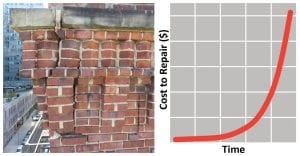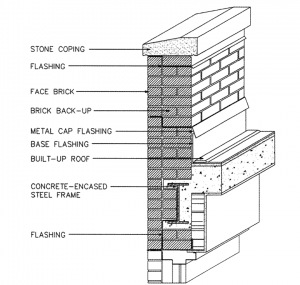Lately, it’s been impossible to avoid the phrase “flatten the curve.” But for building owners, the Covid-19 pandemic isn’t the only curve that should be controlled; the cost of deferred building envelope maintenance can also spiral out of control if not nipped in the bud.

Many building owners and managers are under the erroneous impression that a building’s rate of deterioration is uniform over the life of the property. While degradation of individual building components such as corrosion of steel beams, mortar joint erosion, or roof membrane weathering tends to be constant over time, failure of building systems (interrelated building elements) increases more dramatically with age. That increase translates into exponentially rising repair costs.
Consider, for example, the parapet wall of a typical pre-war office or apartment building. Its system typically includes: coping stones, the mortar or sealant between them, the masonry parapet itself, the concrete roof slab, and the steel beams that support it all. When all the elements of this system are new or in good repair, the coping stones and their mortar or sealant protect the underlying components from the elements.

But time marches on. Small cracks in the coping stones and breaches in their mortar and sealant develop, allowing water to infiltrate the masonry below. The water freezes and expands, acting like a wedge which can force the parapet masonry outward. Breaches continue to grow, allowing more water to intrude. Water migrates down through the concrete roof slab (not inherently waterproof) to the steel framing. The steel beams begin to rust, expanding and pushing the parapet even further outward. Rinse, repeat.
This process continues to accelerate until one of two things happens: either the deterioration becomes evident enough that the owner takes action, or the system fails and a chunk of the parapet lands on the sidewalk or street. Obviously, the latter can endanger both the building and the general public. New York City’s Facade Inspection Safety Program (FISP) helps head off such mishaps, but the steep cost curve of deferred maintenance should be another deterrent to neglect.
Read part 2 to see how proactive maintenance of envelope elements saves owners money and manages liability.
14 Wall Street, 25th Floor, New York, NY 10005
(212) 505 1133
info@superstructures.com
Subscribe to SuperScript, our email newsletter.